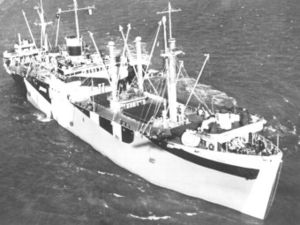USS Fomalhaut (AKA-5)
 USS Fomalhaut as (AK-22) USS Fomalhaut as (AK-22) | |
| History | |
|---|---|
| Launched: | 25 January 1941 |
| Commissioned: | 2 March 1942 |
| Decommissioned: | 25 June 1946 |
| Struck: | Unknown |
| Fate: | Unknown |
| General Characteristics | |
| Displacement: | 3,890 tons |
| Length: | 412 ft 3 in |
| Beam: | 61 ft |
| Draft: | 23 ft 7 in |
| Speed: | 15 knots |
| Complement: | 283 |
| Armament: | 1 × 5"/38 caliber dual purpose gun mount, 4 × 3"/50 gun mounts |
USS Fomalhaut (AKA-5) was an attack cargo ship named after Fomalhaut, a star in the southern constellation Piscis Austrinus. She was commissioned as AK-22, reclassified AKA-5 eleven months later, and reclassified as AE-20 sixteen months after that. Fomalhaut served as a commissioned ship for 4 years and 3 months, receiving five battle stars for World War II service.
1941-1943
Launched 25 January 1941 by Pennsylvania Shipyards, Inc., Beaumont, Tex., as Cape Lookout; sponsored by Mrs. J. A. Boehck; acquired by the Navy 16 May 1941; and commissioned 2 March 1942, Commander J. D. Alvis in command.
Fomalhaut arrived at Samoa 8 May 1942 with passengers and cargo from the east coast. On 22 June, she sailed for Wellington, New Zealand, to load cargo from 30 June to 22 July, and after exercises in the Fijis, sortied for the initial landings of Marines on Guadalcanal and Tulagi on 7 August. During this first American land offensive of the war, Fomalhaut lay anchored in such a position as to observe the Battle of Savo Island 9 August, and that day sailed for Noumea to load additional men and supplies for Guadalcanal.
Returning to Guadalcanal 23 August, Fomalhaut was ordered to take Blue (DD-387), torpedoed the previous day, in tow. But before she could complete unloading and get underway with her tow, an enemy submarine launched a torpedo her way, and Japanese surface forces were reported moving in. As two other destroyers sank Blue to prevent her from possibly falling into enemy hands, Fomalhaut was ordered underway with all but a quarter of her cargo unloaded.
Through a year and a half, Fomalhaut carried out continuous cargo operations in the southwest Pacific, going through some of the hottest fighting of the war supporting the many landings and shore campaigns in the battle for Guadalcanal and the other islands of the southern Solomons. Several times she voyaged to ports in New Zealand or Australia to reload general cargo and stores, and she was often used as a transport.
1944
Fomalhaut returned to Pearl Harbor 9 April 1944 to prepare for the invasion of the Marianas, and sailed 1 June to land troops and their equipment on Charan Kanoa Beach, Saipan, 16 June, the day after the initial assault. On 23 June, she got underway for Eniwetok, Pearl Harbor, and New York City, where she arrived 15 August for overhaul.
After tests and training along the Maine coast, Fomalhaut arrived at Norfolk 7 November 1944 for conversion to an underway ammunition replenishment ship.
1945
In her new role she reported for duty at Ulithi 10 January 1945. Aside from the period 19 to 28 February, when she was at San Pedro Bay, Leyte, arming amphibious ships for future operations, Fomalhaut sailed out of Ulithi to deliver ammunition at sea to combatants and their auxiliaries. On 19 March she returned to San Pedro Bay to load ammunition from merchant ships for ships fighting the battle for Okinawa, off which she arrived 11 May. After a voyage to Saipan, where she touched 2 June, Fomalhaut returned to duty in San Pedro Bay from 7 June to 19 September. She returned to Okinawa and lay there until 7 December when she sailed with homeward bound servicemen for Norfolk, arriving 15 January 1946. Fomalhaut was decommissioned and placed in reserve at Philadelphia on 25 June 1946.
References
- Dictionary of American Naval Fighting Ships (Primary source for this article)